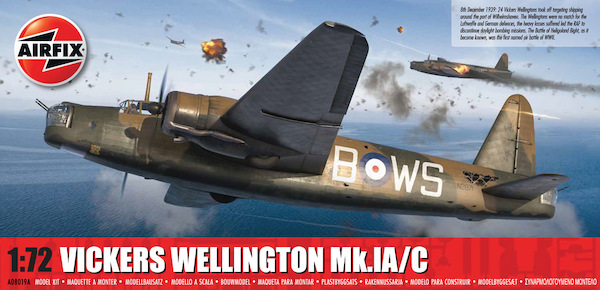
- aviationmegastore.com
- aviationoutletstore.com
- Ship to United States
Quick Search
Aviation Shop
categoriesPublic holidays
Amended or confirmed operating hours of the Luchtvaart Hobby Shop in Aalsmeerderbrug on the following dates:
Aviation Megastore website is available without limitations. Orders are processed during shop operating hours.
| Sa | 27 Apr. | Closed: King's Day |
| Th | 9 May | Closed: Ascension Day |
| Mo | 20 May | Closed: Whit Monday |
Frequent buyers programme
Collect Megapoints for Megavouchers
Read the conditions...
Hold & Store service ©
Aviation Megastore offers unique Hold & Store service © for internet customers that wish to combine several individual orders to one single shipment, reducing the overall shipping cost significantly.
Read more...
Vickers Wellington MK1A/C
Product code 08019A
€ 37.15
Scale 1 : 72
Publisher/Brand Airfix
Category Scale Modelling
Subcategory Scale Modelling
Availability Temporarily Out of Stock.
Click here to be notified when this product becomes available again
This product was added to our database on Friday 16 february 2024.
Your reliable Aircraft Modelling Source since 1989
Product description
Making its first flight on 15th June 1936, the aircraft which took to the skies over the Weybridge factory airfield on that day was very different to the ones which entered service with RAF No.9 Squadron two years later, with its sleek and cultured fuselage looking nothing like a warplane at that stage. Once the design had been perfected and the necessities of military service added, the new Wellington would look much more aggressive and was obviously significantly heavier than the prototype aircraft.
At the start of the Second World War, Britain's bomber force was still relatively modest and definitely still in transition, consisting of around 300 aircraft, made up of both light and medium bomber squadrons. Within this number, however, were eight squadrons of Wellingtons, unquestionably the most capable bomber aircraft available to Bomber Command at that time and the aircraft Britain would be needing to lead the line when it came to offensive operations against enemy forces in occupied Europe.
On 4th September 1939, the day after Britain declared war against Germany, 14 Wellingtons from No's 9 and 149 Squadrons joined a force of Bristol Blenheims in conducting the first RAF bombing raid of the war, as they attacked German warships at the mouth of the river Elbe, near the town of Brunsbuttel. During the attack, two Wellingtons would be lost to enemy fire, becoming the first British aircraft to be lost on the Western Front during the Second World War.
The Wellingtons of Bomber Command would go on to lead Britain's bombing onslaught against Germany, initially flying operations during daylight hours, but after it was discovered the bombers were effectively unable to defend themselves against concerted Luftwaffe fighter attack, would later switch to bombing operations by night. During these early operations, it soon became apparent that the geodetic construction used on the Wellington was one of its greatest attributes, light yet strong and able to withstand immense amounts of punishment. If bullets or shrapnel didn't pass right through the structure of the aircraft, more significant damage didn't cause structural failure and even if there were gaping holes in an aircraft, it managed to keep flying, bringing many a crew back home to safety. Many Wellington crews would owe their lives to the work of Barnes Wallis and his geodetic bomber design.
Reading the recollections recorded by wartime Wellington crews, it does appear that the first flight in the bomber often proved to be a little disconcerting for many, but was again down to the geodetic construction method the aircraft utilised. Although light, incredibly tough and something they would soon come to rely on, the fuselage of a Wellington did possess the ability to flex slightly, something crews became aware of as the aircraft was taxiing toward the runway for their first flight. As the aircraft turn to following the perimeter track prior to take-off, it appeared as if the fuselage was snaking slightly as it followed the nose of the aircraft, however, this only proved worrisome on that first occasion.
In other instances, when a Wellington was being used in a glider towing capacity, this flexing was perhaps a little more noticeable, as the weight of the glider tended to cause some longitudinal flexing of the aircraft's geodetic structure.
The Wellington and its distinctive method of construction would go on to become the most heavily produced British bomber aircraft in history, serving from the first minute of the Second World War, right through to the last. Of the 11,461 Wellingtons produced, the final one to leave the factory would do so on 13th October 1945, with the last training variant of the aircraft only being withdrawn from RAF service in 1953.
As an attempt to satisfy a demanding, if rather ambiguous RAF requirement for a modern medium bomber back in 1932, the Vickers Wellington would go on to make quite a name for itself in aviation history terms.
Markings for:
- Vickers Wellington Mk.IA, No. 9 Squadron Aircraft, Royal Air Force Honington, Suffolk, England, 18th December 1939. (A)
- Vickers Wellington Mk.IC, Luftwaffe, formerly 311 (Czechoslovak) Squadron, 1941. (B)
- aviationshopsupplies.com
- aviationmegatrade.com
© 1989–2024 Luchtvaart Hobby Shop B.V.
